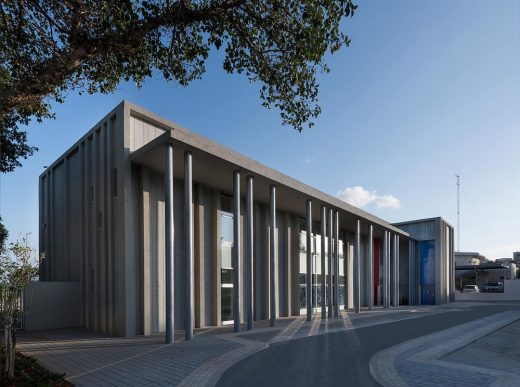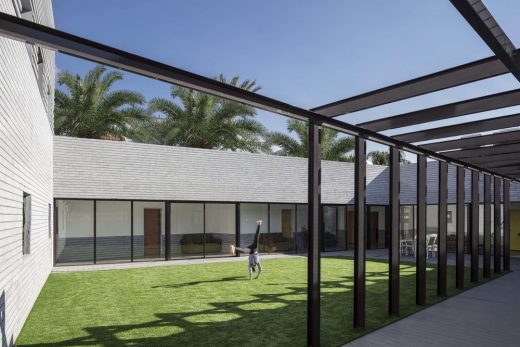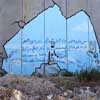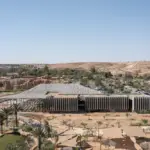West Bank Wall, Israel World Heritage, Palestinian Building Project, Structure, Design
West Bank Wall Israel
World Heritage Site Proposal – Palestinian Discussion: Development in the Middle East
25 May 2009
West Bank Wall
Special Subject (World Heritage)
Article by Frazer Hay for e-architect
e-architect Newsletter No. 5 – Article
Outstanding universal value assessment criteria [ii], [iii] and [iv]
“It’s a mistake to say that heritage has to be nice, I think the painful aspects of heritage can be quite important too because you need to confront those, in order to come to terms with your past. That’s why on the World heritage List you’ve got places like Auswitch and Hiroshima ……very few heritage designation systems say that heritage needs to be pretty”
[Christopher Young English Heritage International Policy Director BBC4 Interview 19th May 2009 2000hrs]
West Bank Wall : PDF with images 1.6MB
This document proposes the West Bank Wall separating Israel from Palestine be listed as a World Heritage site. This important site has huge cultural significance internationally and is a key iconic structure which highlights the struggle between cultures and religious beliefs. The West Bank is no different from the other walls in our history which have divided people and fuelled conflict and oppression. The Berlin Wall and Hadrian’s Wall in the UK are now seen as heritage sites but were in there time no-less sensitive and brutal in their nature. Crucially the Berlin Wall was not given any sort of protection and as a result fell victim to misuse and abuse at the hands of such things as eBay itself an iconic phenomena of our contemporary consumerist culture in the twentieth and twenty-first centuries.
The wall has already become a vehicle for cultural expression as contemporary international artists such as “Banksy” highlight. The artists have adopted its symbolism and cultural canvas to voice political expression in the form of graffiti. In fact a scheme organised in collaboration between a Dutch Christian organization and members of the Palestinian Peace and Freedom Youth Forum, has evolved so that you can pay $40 to have an artist tag the wall through the www.sendamessage.nl website. Proceeds will support grassroots social and cultural projects in the West Bank.
Description
First proposed by Yitzhak Rabin [the fifth Prime Minister of Israel] in 1992 following the murder of a teenage girl in Jerusalem, the Israeli West Bank wall was built as a necessary device to protect Israeli civilians from Palestinian terrorist attack. The controversial nature of the wall can simply be read by the fact that both sides call it very different names. The Israelis call it the separation fence, or the security fence, or even the anti-terrorist fence, whereas the Palestinians call it the racial segregation wall or the apartheid wall. In fact the name alone is such an issue that the BBC’s Journalist guide states: “The BBC uses the terms barrier, separation barrier or West Bank barrier as acceptable generic descriptions to avoid the political connotations of “security fence” preferred by the Israeli government or “apartheid wall” preferred by the Palestinians.” [BBC News 2008]
The wall is 436 miles long and due to complete its final stage of construction in 2010. Ninety per cent of the wall is in fact a multi-layered fence system 50metres wide – only 10% of the wall is actually made of concrete – (3m wide) and the concrete sections exist exclusively within urban conditions. The wall is part of a trio of walls. The other two are the Gaza Strip barrier and the Gaza- Egypt wall built in 1994. The West Bank wall largely follows the Armistice Line or Green Line which separates the West Bank with Jordan.
The wall has affected the Palestinians in a number of ways – in a reduction of freedom, loss of land, increased difficulty in accessing medical services in Israel, restricted water access, economic implications and political upheaval. The affects on Israel are in complete contrast to the Palestinian experience in that civilians now have a far greater protection from suicide bombings and other terrorist activity. However there have been some unexpected effects on demographics and with financial implications.
“It is difficult to overstate the humanitarian impact of the barrier. The route inside the West Bank severs communities, people’s access to services, lively hoods and religious and cultural amenities. In addition, plans for the barrier’s exact route and crossing points through it are often not fully revealed until days before construction commences. This has lead to considerable anxiety amongst Palestinians about how their future lives will be impacted. The land between the barrier and the green line constitutes some of the most fertile in the west bank. It is currently the home for 49,400 West Bank Palestinians living in 38 villages” [UN report Pg4, 2005]
United Nations 2003 declares the barrier illegal [International Court of Justice] calling for the removal barrier. The International Court of Justice issuing an advisory opinion;
“The Court finds that the construction by Israel of a wall in the occupied Palestinian territory and its associate regime are contrary to international law” [United Nations 2003]
The Red Cross 2004 declared the barrier was in violation of the Geneva Convention and poses serious legal and humanitarian issues which should be addressed immediately.
The fully constructed structure will in fact, be part-wall, part-fence. The majority of its 436 mile length is made up of a concrete base with a five-metre-high wire-and-mesh fabric. Rolls of razor wire and a four-metre-deep ditch are placed on one side. The barrier will be fitted with electronic sensors and a fine earth-covered “trace road” parallel to it, where footprints of anyone crossing can be identified.
Urban sections of the structure consist of 8m solid concrete walls, complete with panopticon watchtowers.
The solid sections around the Palestinian town of Qalqilya have already been locally renamed as the “sniper wall” to thwart gun attacks against Israeli motorists on the close by Trans-Israel Highway.
Identification of Values:
The West Bank Wall can legitimately claim a wide variety of heritage values from ‘Evidential Value’ to ‘Spiritual Value’ however for the purpose of this document the main values highlighted will be the West Bank Wall’s, ‘Social and Symbolic, Communal Values’ and ‘Associative and Illustrative Historic Values’
The criteria for the Wall is set within the cultural heritage sections of the universal value assessment [Outstanding universal value assessment criteria [ii], [iii] and [iv]], rather than the natural heritage section. [Ref: appendix 2]
The Communal Value is split in to social and symbolic values. The Wall’s symbolic value can be read in its meaning of place for those who draw their identity from it or have emotional links to it. However it’s the Wall’s ability in reminding us of the current uncomfortable events, attitudes and cultural divide [which has had an affect on us worldwide], that underlines its main value. The wall symbolises the cultural differences that fuel the conflict between faiths and lifestyle. It is a structure that has a duplicitous meaning to both sides – thus underpining the difficulties in the Middle East. The wall has and will further be an aspect of collective memory whose meaning should never be forgotten. Its building illustrates a significant stage in human history. [Criteria iv – Ref: appendix 2] The social value can be found in its ability to help define national identities, strengthen bonds culturally and promote a communities sense of its self. The Wall indicates an interchange of human values in a cultural area of the world, highlighting a conflict of religious beliefs and land ownership.
The Wall’s Historic Value can be read as Associative and Illustrative values. The Associative value is evident in the way the Wall reflects a modern period of historical, political and cultural affiliations. The Wall bears a unique or at least exceptional testimony to a cultural tradition of terrorist warfare and struggle for cultural and national autonomy. [Criteria iii – Ref: appendix 2]
Authenticity & Integrity:
The site’s authenticity and integrity can be addressed in the NARA DOCUMENT ON AUTHENTICITY World heritage convention 1994 in co-operation with UNESCO, ICCROM and ICOMOS. Given that the West Bank wall is current, accessible and well documented from all cultural perspectives, and that the sources of information can be relatively easily monitored, assessing the values of the site for credibility and truthfulness is much easier for the heritage authorities – far easier than it would be, for example to assess the values of ‘Paleolithic’ construction.
The integrity is a measure of wholeness and intactness of the wall. In other words the West Bank Wall should be in good condition and have a significant proportion of its elements necessary to convey the totality of the values highlighted above. The fact that the West Bank Wall is relatively new and still has one year until completion, the integrity with regards the World Heritage stipulations are relatively easy to comply to. In fact, the site’s integrity is one of the underlying reasons in applying for the wall’s classification – and the chance to protect the totality of the site and all its elements for future generations.
Comparative assessment:
The Berlin Wall, Germany
“The Berlin Wall (or our image of the wall) was not only a symbol, especially from a western point of view, the wall (or the function of the wall) was also an elaborate and life threatening system against basic human rights. The wall itself was brought to perfection stepwise from 1961 to 1989 and it was extended to a complex of more than 160 kilometres length including the Border Wall (Vorderlandmauer) itself, rearwards followed by a broad no-men’s-land with patrol track and light strip in front of the Hinterland Wall (Hinterlandmauer) or Hinterland Fence, which was fortified additionally by obstacles such as electric signalling fences, dog runs, advanced perimeter defence etc.. Apart from the Border Wall, that was visible from the West, about 300 watchtowers became part of our image of the Berlin Wall”.
“Prof. Jörg Haspel Where is the Berlin Wall?” – from a hated heritage to missed monuments”
Built in 1961 the East German government constructed the Berlin Wall to control movement, communication and commerce. Like the West Bank Wall, the Berlin Wall became a symbolic construction that reinforced borders and helped highlight political, cultural and social conflict. The Berlin Wall was an important marker in our cultural heritage and a particular period of our recent history. The wall became an icon of the cold war separating communism from capitalism, a tangible iron curtain, a monument to the perils of world conflict.
Hadrian’s Wall, UK
Eighty miles long and spanning the width of the country, Hadrian’s Wall was built AD122 and constructed to keep order, control trade and defend the northern frontier of the Roman Empire. The Wall became a symbol of Roman power whilst also highlighting military difficulties in dealing with the gorilla warfare tactics of the Pictish tribes who were the ancient inhabitants of Scotland. The wall was made a UNESCO World Heritage Site in 1987. Hadrian’s Wall has quite obvious parallels with the West Bank Wall in that it was erected to manage economics and control the aggressive and difficult to manage behaviour of the indigenous population whilst signifying strength and power to the world.
Statement of significance:
The West Bank Wall is a structure with outstanding universal value [assessment criteria [ii], [iii] and [iv]]
and provides outstanding testimony to the current struggle between the Christian and Muslim faiths. The Wall indicates the interchange of human values in a cultural area of the world, highlighting a conflict of religious beliefs and land ownership. The wall is iconic of the conflict in the Middle East and underpins the wider issues of terrorism and guerrilla warfare tactics and the defence methods employed to counter the effects.
This building of the Wall / fence / barrier/ separation device illustrates a significant stage in human history and has duplicity of meaning and emotion woven within the fabric of its existence. An existence that is tricky and sensitive to address but this should not be a reason to shy from listing this important structure and protecting its integrity for future generations to contemplate and learn from. [Please ref to appendix 3]
Like the ‘Berlin Wall’ and ‘Hadrian’s Wall,’ the West Bank Wall should be recognised as a valid heritage site steeped with cultural significance and although illegal, ugly, unpopular, controversial and in some aspects embarrassing, should be given the same respect as a marker in history. Given that it is four times longer and twice the height of the Berlin Wall there may be a compromise to be had, in the listing of specific urban elements such as the fence system, concrete wall, sniper wall, access gates and the lookout towers.
These elements could be discussed providing enough is left intact to ensure ‘Authenticity’ and ‘Integrity’ unlike the ‘Berlin Wall’ which has been lost in a physical sense and more importantly in meaning. Perhaps the new generation of historic walls and barriers such as the West Bank Wall and the Mexico-USA Security fence should have put in place an early management and listing plan, so that they too can develop as monuments of their time such as the Great Wall of China and Hadrian’s Wall.
West Bank Wall Israel Discussion re World Heritage Site from Frazer Hay 260509
Location: Israel
Israel Architecture
Contemporary Architecture in Israel
Israeli Architecture Designs – chronological list
Jerusalem Architecture Walking Tours
Contemporary Israel Community Buildings Selection
Community Centre for People with Disabilities, Holon
Design: Golany Architects

photography : Amit Gosher
Community Centre for People with Disabilities, Holon
The Ada and Tamar House, near Tel-Aviv
Design: Amos Goldreich Architecture

photograph : Amit Gosher
Shelter for Victims of Domestic Violence near Tel-Aviv
Kofinas Information Centre, Tzur Moshe
Design: Ron Shenkin Studio

photograph : Shai Epstien
Kofinas Information Centre in Tzur Moshe
Tel Aviv Architecture Walking Tours
Comments / photos for the West Bank Wall Israel Architecture page welcome





